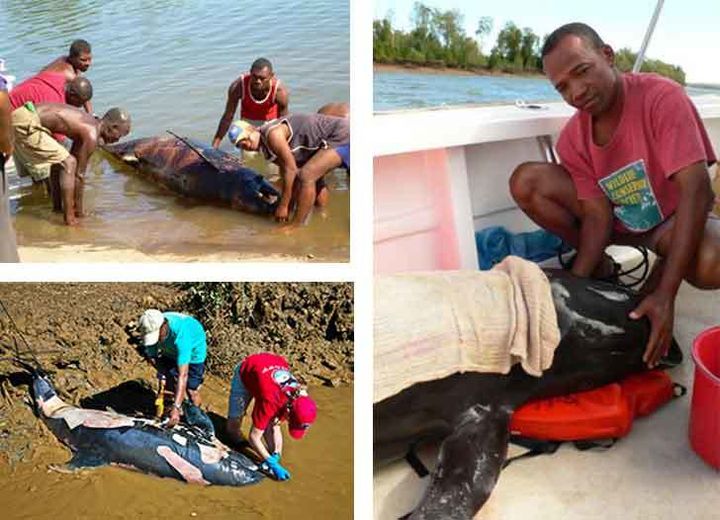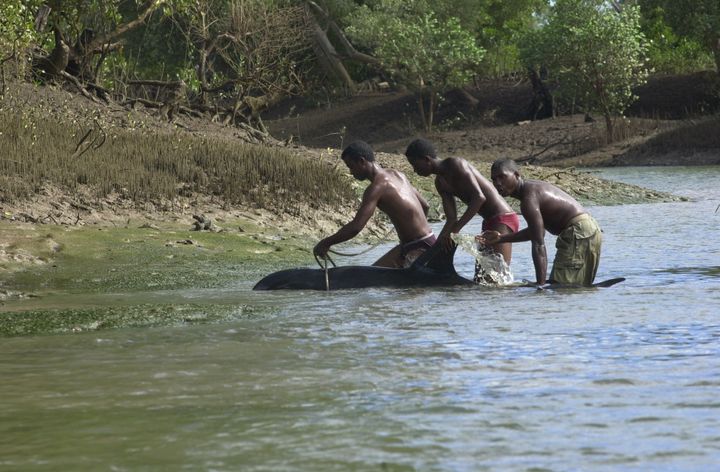This story starts on a typically breezy and hot day on a beach in Madagascar. Two small whales stranded on the sand and died, their gleaming bodies still fresh enough to be eaten by the astonished villagers who carried them off.

Rescuers attempted to save the whales.
But that was just the beginning – the brackish and turbid water of the the nearby Loza Lagoon began to fill with panicked whales swimming desperately away from the ocean world they knew. By the afternoon the deep ocean dwelling melon-headed whales had traveled 65 kilometers (40 miles) inland.
Slowly the lost and confused whales began to die. Amid the tangled mangroves, mudflats and on narrow beaches their skin blistered and their body temperature rose until death came as a reprieve. Impoverished villagers caught and ate an unknown number. Of the estimated 100 -200 melon-headed whales that entered the lagoon only a handful were known to survive, and finally, after nearly a month only four whales were seen leaving the lagoon and heading out to sea.
What had caused the mayhem? After years of meticulous study scientists concluded that the culprit could be summed up in one word:
Sonar.
Earsplitting, terrifyingly loud and relentless, the sound had bounced off the underwater cliffs and canyons in the deep ocean. It drove the whales out of their familiar habitat with nowhere to escape until they sought refuge in the lagoon. Safe from the frightening sound they swam into the confusing labyrinth where even those who tried to rescue them could do little to help.
ExxonMobil and their partners were eventually shown to be responsible.
The oil companies had been mapping the ocean floor along the coast prior to doing seismic surveys when the stranding occurred, using the type of sonar that had caused the deaths of whales by the navy in the Bahamas in 2000. In War of the Whales, author Joshua Horwitz carefully documents the relationship between navy sonar and whale deaths but the Madagascar fiasco was the first time that the private sector – big oil – had been held accountable.
There is no way to know how many other species were affected and/or died in the ocean or at other remote locations during this one sonar mapping fiasco and in the end the whale deaths were for nothing: ExxonMobil and its partners just didn’t find a significant enough puddle of oil hidden under the seafloor to be worthwhile.

The deep ocean whales swam 65 km inland to escape the sonar. Rescue was difficult.
And now big oil is poised to repeat their activities off the Atlantic coast of the US. Marine life will have to endure various seismic challenges, from the sonar that drove the melon-headed whales to seek safety where the noise couldn’t penetrate (but for which they were not adapted to survive), to the repeated nearly year long pounding of seismic noise.
Once big oil gets its hooks into the Atlantic seabed there will be no turning back, no way to unwind that clock. Even if they never cause a spill or erect a rig, untold damage will happen to marine life, from the tiniest organisms (see Seismic surveys now proven to kill zooplankton…there goes your crab dinner) to the great whales. And they can’t wait to get started.

Pilot whale stranding event in New Zealand.
WHAT YOU CAN DO: Your comments to NOAA do matter!
NOAA Fisheries wants the public to weigh in on this – the oil companies can’t operate seismic surveys unless they get permits from the energy bureau, and the energy bureau won’t issue permits unless NOAA is satisfied that existing restrictions are met.
Three simple steps:
1) Go to the Federal Register website and familiarize yourself with the process.
2) Choose current research to support your comments. (You can click on one of these links, copy the abstract, and paste into your letter).
- Natural and anthropogenic ocean noise recorded at long-term and temporary observatories
- High suckling rates and acoustic crypsis of humpback whale neonates maximise potential for mother–calf energy transfer
- Cetacean sightings and acoustic detections during a seismic survey off Nicaragua and Costa Rica, November-December 2004
- Nowhere to go: noise impact assessments for marine mammal populations with high site fidelity
3) Email your comments to: ITP.Laws@noaa.gov by July 6th.
But remember, NOAA will NOT consider comments other than as specified. “We will only consider comments that are relevant to marine mammal species that occur in U.S. waters of the Mid- and South Atlantic and the potential effects of geophysical survey activities on those species and their habitat.”
Background information:
From Trump’s executive order “Implementing an America-First Offshore Energy Strategy”
“Sec. 9. Expedited Consideration of Incidental Harassment Authorizations, Incidental-Take, and Seismic Survey Permits. The Secretary of the Interior and the Secretary of Commerce shall, to the maximum extent permitted by law, expedite all stages of consideration of Incidental Take Authorization requests, including Incidental Harassment Authorizations and Letters of Authorization, and Seismic Survey permit applications under the Outer Continental Shelf Lands Act, 43 U.S.C. 1331 et seq., and the Marine Mammal Protection Act, 16 U.S.C. 1361 et seq.Sec. 10. Review of National Oceanic and Atmospheric Administration (NOAA) Technical Memorandum NMFS-OPR-55. The Secretary of Commerce shall review NOAA’s Technical Memorandum NMFS-OPR-55 of July 2016 (Technical Guidance for Assessing the Effects of Anthropogenic Sound on Marine Mammal Hearing)… take all steps permitted by law to rescind or revise that guidance, if appropriate.
References and further reading:
- Seismic Survey Market Worth 9.28 Billion USD by 2022 http://www.prnewswire.com/news-releases/seismic-survey-market-worth-928-billion-usd-by-2022-628364483.html
- 2D, 3D & 4D Seismic Reflection Imaging https://www.tcd.ie/Geology/assets/pdf/geology-for-engineers/L08_2D3D4D_seismic.ppt.pdf
- One of the proposed seismic surveys, 34,258 miles, lasting 308 days http://www.nmfs.noaa.gov/pr/permits/incidental/energy/atlg_g_2015iha_pubcomm.pdf
- Technical Acoustic Guidance FAQs http://www.nmfs.noaa.gov/pr/acoustics/faq.htm
- Technical Guidance for Assessing the Effects of Anthropogenic Sound on Marine Mammal Hearing http://www.nmfs.noaa.gov/pr/acoustics/Acoustic%20Guidance%20Files/opr-55_acoustic_guidance_tech_memo.pdf
- Bureau of Ocean Energy Management (BOEM) Protective Measures https://www.boem.gov/Protective-Measures/
- Madagascar [melon-headed whale stranding] ISRP ( Independent Scientific Review Panel) FINAL REPORT https://iwc.int/private/downloads/SLvy5e15tG6X7IECFfK0aQ/Madagascar%20ISRP%20FINAL%20REPORT.pdf
Other affected marine life:
- Seismic survey noise disrupted fish use of a temperate reef
- Offshore exposure experiments on cuttlefish indicate received sound pressure and particle motion levels associated with acoustic trauma
- A sound approach to assessing the impact of underwater noise on marine fishes and invertebrates
- Widely used marine seismic survey air gun operations negatively impact zooplanktonGood or bad vibrations? Impacts of anthropogenic vibration on the marine epibenthos
